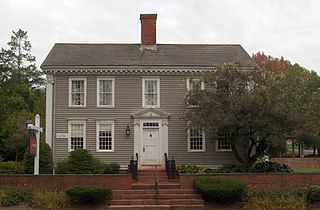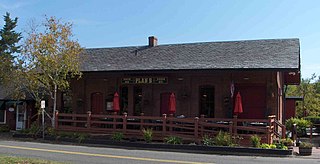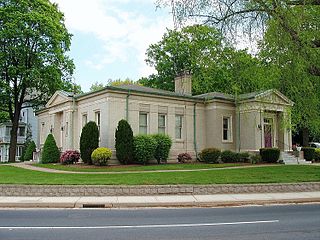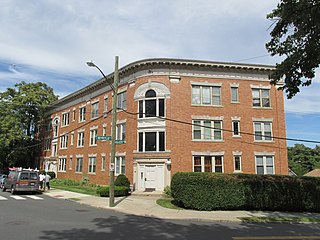
Simsbury is a town in Hartford County, Connecticut, United States. The population was 23,511 at the 2010 census. The town was incorporated as Connecticut's 21st town in May 1670.

The Simsbury Center Historic District is a 75-acre (30 ha) historic district located in the town center area of Simsbury, Connecticut. It encompasses seven blocks of Hopmeadow Street, as well as the cluster of commercial, civic, and residential buildings along Railroad, Station, and Wilcox Streets, and Phelps Lane. Although its oldest element is the cemetery, most of its buildings were built in the late 19th and early 20th century. It was listed on the National Register of Historic Places in 1996.

Simsbury station is a former railroad station in the center of Simsbury, Connecticut. Built in 1875, it is a distinctive example of a railroad station with Italianate styling. The building was listed on the National Register of Historic Places on March 26, 1976 as Simsbury Railroad Depot. Presently, it houses a restaurant, called "Plan B".

The Horace Belden School and Central Grammar School are a pair of architecturally distinguished Late Gothic Revival occupying a single campus at 933 Hopmeadow Street and 29 Massaco Street in Simsbury, Connecticut. The Belden School was built in 1907 as the first Simsbury High School, and now serves as Simsbury Town Hall. The Central Grammar School, built in 1913, is now called the Central School. The buildings were listed as a pair on the National Register of Historic Places in 1993 for their architecture and their role in the town's educational system.

The Robert and Julia Darling House, now the Cannon Building, is a historic house at 728 Hopmeadow Street in Simsbury, Connecticut. Built in 1927 for a local business leader, it is one of the town's largest and most distinctive examples of Colonial Revival architecture. The house was listed on the National Register of Historic Places in 1991. It now houses professional offices.

Eno Memorial Hall is a historic civic building at 754 Hopmeadow Street in Simsbury, Connecticut. Built in 1932, it served historically as a courthouse, as a city hall, as an auditorium, and as government offices. It was designed by Roy D. Bassette, and was given to the town by Antoinette Eno Wood, who was descended from some of the town's early settlers. It presently serves as the town's senior center. The hall was listed on the National Register of Historic Places in 1993.

Smith & Bassette was an architectural firm based in Hartford, Connecticut. Its partners included H. Hilliard Smith and Roy D. Bassette. It was active from 1911 to 1946.

The Simsbury Townhouse is a historic municipal building at 695 Hopmeadow Street in Simsbury, Connecticut. Built in 1839, it was Simsbury's town hall until 1931, and is a good local example of Greek Revival architecture. It was listed on the National Register of Historic Places in 1993. It continues to serve as a community resource.

The Southington Public Library is the public library serving Southington, Connecticut. It is located at 255 Main Street in a modern facility erected in 1974. Its first building, constructed in 1902 and located at 239 Main Street, now houses the Southington Historical Center. That building, a fine local example of Classical Revival architecture, was listed on the National Register of Historic Places in 1989.

The Enfield Town Meetinghouse is a historic Greek Revival style meeting house located on Enfield Street at South Road in Enfield, Connecticut. Completed in 1775 and moved and restyled in 1848, it hosted the municipal government until the 1920s. Now managed by the local historical society as a museum, it was listed on the National Register of Historic Places in 1974.

Argos Downtown Historic District is a national historic district located at Argos, Marshall County, Indiana. The district encompasses 21 contributing buildings in the central business district of Argos. It developed between about 1867 and 1942, and includes examples of Italianate, Romanesque Revival, and Neoclassical style architecture. Notable buildings include the Reed Block (1891), Williams Inn (1838), IOOF #263 Hall (1901-1907), Corner Hardware Building (1883), Argos Reflector Building / GAR Hall, Argos Theater, Sarber Building (1892-1898), Old Argos Opera House / Huff Block (1887-1892), Pickerl Block, Argos Municipal Building (1940), Farmers State Bank Block (1917), Argos Masonic Lodge #399 / Grossman Building (1906), Schoonover Building, and Pickerl Residence.

Damon Hall, also known as Hartland Town Hall, is located at the junction of United States Route 5, Quechee Road, and Vermont Route 12 in the village center of Hartland, Vermont. Built in 1914-15 as a memorial to the locally prominent businessman William E. Damon, it is a fine local example of Colonial Revival architecture, and has served the town in many capacities since its construction. It was listed on the National Register of Historic Places in 1988.

The United Bank Building is a historic commercial building at 19–21 Main Street in downtown New Milford, Connecticut. Designed by Wilson Potter and built 1902–04, it is a prominent local example of Classical Revival architecture, built to house two banks whose previous buildings had been destroyed in a devastating fire. The building was listed on the National Register of Historic Places in 1982, and is a contributing element of the New Milford Center Historic District.

The Ambassador Apartments are a historic residential complex at 206-210 Farmington Avenue in Hartford, Connecticut. Completed in 1921, it is a significant local example of Renaissance Revival architecture, designed by the prominent local firm of Berenson and Moses. It was listed on the National Register of Historic Places in 2008.

The Burritt Hotel was a historic hotel at 67 West Main Street in New Britain, Connecticut, United States. Built in the 1920s to attract business travelers, it was the city's most luxurious hotel. It is now Burritt House, an affordable housing complex. The building was listed on the National Register of Historic Places in 1983.

Footguard Hall is the headquarters and armory of the First Company Governor's Footguard of the state Connecticut, a ceremonial military company founded in 1771 and originally tasked with protecting the governor and state legisature. It is located at 159 High Street, in Hartford, Connecticut, in a Romanesque Revival brick building built in 1888. The building was listed on the National Register of Historic Places in 1984 in recognition of the organization's history and its distinctive architecture.

The Myers and Gross Building is a historic apartment building at 2 Fraser Place in Hartford, Connecticut. Built in 1917, it is a well-preserved example of Georgian Revival architecture. It was listed on the National Register of Historic Places in 1983.

Marlborough House is a historic private residence at 226 Grove Street in Bristol, Connecticut. Built in 1929 for a local businessman, it is a prominent local example of Georgian Revival architecture. It was listed on the National Register of Historic Places in 1993.

The 1917 Noah Webster Memorial Library building is a historic library building at 7 North Main Street in West Hartford, Connecticut. Built to a design by the Hartford firm Davis & Brooks, it is a prominent local example of Colonial Revival architecture. It housed the town library between 1917 and 1937, and later served as a YMCA/YWCA hall and a senior center. It was listed on the National Register of Historic Places in 1981. It is now used as a commercial space.

The Hamden Bank & Trust Building is a historic commercial building at 1 Circular Drive in Hamden, Connecticut. Built in 1927, it is a fine local example of Classical Revival architecture. It was listed on the National Register of Historic Places in 1990. Used as a bank for many years, it now houses professional offices.






















